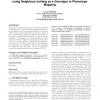111 search results - page 1 / 23 » Inferring Phylogenetic Trees Using Answer Set Programming |
LPNMR
2009
Springer
13 years 9 months ago
2009
Springer
This note summarizes the use of Answer Set Programming to solve various computational problems to infer phylogenetic trees and phylogenetic networks, and discusses its applicabilit...
JAR
2007
13 years 4 months ago
2007
We describe the reconstruction of a phylogeny for a set of taxa, with a character-based cladistics approach, in a declarative knowledge representation formalism, and show how to u...
GECCO
2005
Springer
13 years 10 months ago
2005
Springer
Evolutionary relationships among species can be represented by a phylogenetic tree and inferred by optimising some measure of fitness, such as the statistical likelihood of the t...
TCBB
2008
13 years 4 months ago
2008
Reconstruction of phylogenetic trees is a fundamental problem in computational biology. While excellent heuristic methods are available for many variants of this problem, new adva...
BMCBI
2008
13 years 5 months ago
2008
Background: In plant mitochondria, the post-transcriptional RNA editing process converts C to U at a number of specific sites of the mRNA sequence and usually restores phylogeneti...


